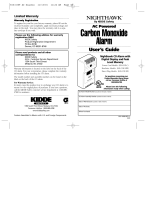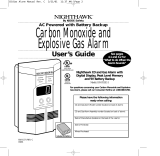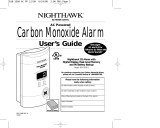1. Information About Carbon Monoxide
Because carbon monoxide is a cumulative poison, long-term exposures
to low levels may cause symptoms, as well as short-term exposures to
high levels. This Kidde unit has a time-weighted alarm – the higher the
level of CO present, the sooner the alarm will be triggered.
This CO alarm can only warn you of the presence of CO. It does not
prevent CO from occurring, nor can it solve an existing CO problem. If
your unit has alarmed and you’ve provided ventilation by leaving your
windows and doors open, the CO buildup may have dissipated by the
time help responds. Although your problem may appear to be
temporarily solved, it’s crucial that the source of the CO is determined
and that the appropriate repairs are made.
This CO alarm is designed to act as a monitor; it is not designed for use
as a short-term testing device to perform a quick check for the presence
of CO.
CO alarms have limitations. Like any other electronic device, CO alarms
are not fool-proof. CO alarms have a limited operational life. You must
test your CO alarm weekly, because it could fail to operate at any time.
If your CO alarm fails to test properly, or if its self-diagnostic test reveals
a malfunction, immediately have the unit replaced. This alarm will not
monitor CO levels while in an error condition.
CO alarms can only sense CO that reaches the unit’s sensor. It’s possible
that CO may be present in other areas without reaching the alarm. The
rate and ability that which CO reaches the alarm may be affected by:
• Doors or other obstructions.
• Fresh air from a vent, an open window or other source.
• CO being present on one level of the home and not reach a CO alarm
installed on a different level. (For example, CO in the basement may
not reach an alarm on the second level, near the bedrooms).
For these reasons, we recommend you provide complete coverage by
placing a CO alarm on every level of the home. Please carefully read all
information in sections 2 and 3 on properly installing this CO alarm.
CO alarms should not be used to detect the presence of natural gas
(methane), propane, butane, or other combustible fuels.
Instruct children never to touch, unplug or otherwise interfere with the
alarm. Warn children of the dangers of CO poisoning.
























